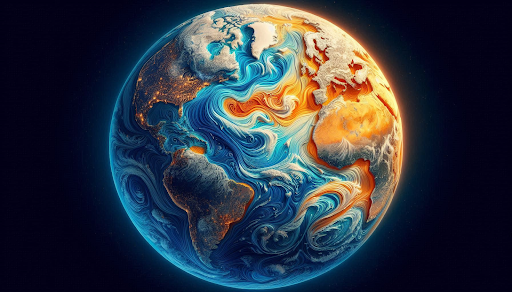Movements of Ocean Water – Complete Guide for Class 11 Geography Chapter 13

Welcome to iPrep, your Learning Super App. Our learning resources for the chapter “Movements of Ocean Water” in Geography for Class 11th are designed to ensure that you grasp this concept with clarity and perfection. Whether you’re studying for an upcoming exam or strengthening your concepts, our engaging animated videos, practice questions, and notes offer the best of integrated learning with interesting explanations and examples.
This chapter explores the various movements of ocean water, focusing on waves, tides, and ocean currents. Each aspect is crucial for understanding marine dynamics and their impact on the environment.
The movements of ocean water play a vital role in shaping the Earth’s climate, supporting marine ecosystems, and influencing human activities. This chapter delves into three primary forms of ocean movement: waves, tides, and ocean currents. Each of these phenomena has unique characteristics and functions, which together contribute to the intricate balance of our planet’s oceanic systems. Understanding these movements is essential for grasping broader geographical concepts and environmental interactions.
Objectives of Learning The Chapter – Movements of Ocean Water
Now that we have explored the importance of the chapter, let’s outline the objectives of studying it.
- To understand the characteristics and formation of ocean waves.
- To explore the nature and types of tides, including their significance.
- To examine the features and classifications of ocean currents.
- To analyze the impact of ocean currents on global weather patterns and marine life.
Now let’s explore the various sections of the chapter.
Now, to understand the first major movement of ocean water, let’s delve into the section on waves.
Waves
Characteristics of Waves
- Waves are rhythmic movements of water caused by wind.
- They vary in height, length, and speed.
- Key terms include crest (top of the wave), trough (bottom), wavelength, and amplitude.

Next, we will explore tides, another significant movement of ocean water.
Tides
Tides of Bay of Fundy, Canada
- The Bay of Fundy is known for having the highest tides in the world.
- Tidal ranges can exceed 16 meters (over 50 feet).
Types of Tides
Tides Based on Frequency
- Semi-diurnal Tide: Two high tides and two low tides each day.
- Diurnal Tide: One high tide and one low tide each day.
- Mixed Tide: A combination of semi-diurnal and diurnal tides, leading to variations in tidal range.
Tides Based on the Sun, Moon, and Earth Positions
- High Tide: Occurs when the gravitational pull from the moon is strongest.
- Spring Tides: Higher high tides and lower low tides that occur when the sun, moon, and Earth are aligned.
- Neap Tides: Lower high tides and higher low tides that occur when the sun and moon are at right angles to each other.

Importance of Tides
- Tides influence coastal ecosystems and marine navigation.
- They play a crucial role in nutrient distribution in oceans.
Finally, let’s examine ocean currents, which are essential for understanding global oceanic movement.
Ocean Currents
Characteristics of Ocean Currents
- Ocean currents are large-scale flows of seawater driven by wind, water density, and Earth’s rotation.
- They can be surface currents or deep-water currents.
Types of Ocean Currents
Ocean currents can be classified based on various criteria.
Classified Based on Depth
- Surface Currents: Found in the upper 400 meters of the ocean and influenced by wind.
- Deep Water Currents: Driven by differences in temperature and salinity.
Classified Based on Temperature
- Warm Currents: Move from the equator towards the poles.
- Cold Currents: Move from the poles towards the equator.
Major Ocean Currents
- Gulf Stream: A warm current that influences climate in North America and Europe.
- Humboldt Current: A cold current that brings nutrient-rich waters to the surface along the west coast of South America.
Effects of Ocean Currents
- Ocean currents impact global climate and weather patterns.
- They affect marine biodiversity and the distribution of marine species.

Finally, as we have gained comprehensive knowledge about the chapter “Movements of Ocean Water”, let’s reflect on the overall learning value of this important lesson.
Overall Learning Value of the Chapter
In conclusion, the chapter on the movements of ocean water provides valuable insights into the dynamic processes of waves, tides, and ocean currents. Each movement plays a crucial role in shaping our planet’s ecosystems and climate. Understanding these phenomena enhances our awareness of environmental changes and the importance of preserving our oceans.
Let’s Conclude
In conclusion, the chapter “Movements of Ocean Water” for CBSE Class 11th Geography provides a deep understanding of the various forces at play within our oceans. From waves and tides to complex ocean currents, each movement of ocean water has a unique impact on marine life, global climates, and coastal ecosystems. By studying “Movements of Ocean Water” in Geography for Class 11th, students gain valuable knowledge about how these natural processes interact to shape our world. With iPrep’s engaging resources, exploring “Movements of Ocean Water” becomes an enriching experience, empowering students in Class 11th Geography to connect with the vital functions of our oceans.
Practice questions on Chapter 13 - Movements of Ocean Water
Get your free Chapter 13 - Movements of Ocean Water practice quiz of 20+ questions & detailed solutions
Practice Now








